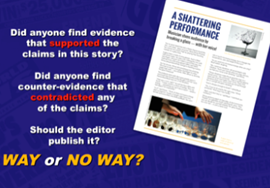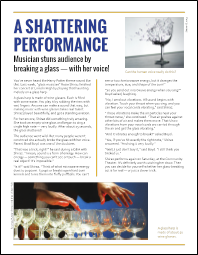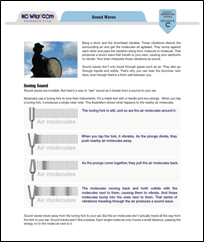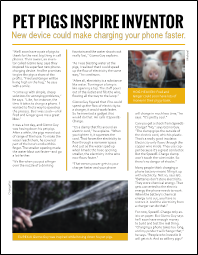In this activity, students become editors at NoWay!com, a website that publishes amazing-but-true stories. Two stories being considered for publication include claims about energy and electricity. Students must evaluate the validity of the claims by looking for relevant evidence in the informational resources provided. Based on what they find, they decide whether or not the site should publish the stories.
![]() This classroom activity, a central feature of our modules, offers a fun way for students to develop the critical thinking and science literacy skills emphasized in the Next Generation Science Standards—skills they’ll need in order to become critical consumers of scientific information and reporting. Moving away from the fantasy worlds of the video games, No Way! draws students into a compelling real-life scenario in which they are editorial interns at a science-themed website—NoWay!com.
This classroom activity, a central feature of our modules, offers a fun way for students to develop the critical thinking and science literacy skills emphasized in the Next Generation Science Standards—skills they’ll need in order to become critical consumers of scientific information and reporting. Moving away from the fantasy worlds of the video games, No Way! draws students into a compelling real-life scenario in which they are editorial interns at a science-themed website—NoWay!com.
 |
| After evaluating the claims in a story, students decide whether the site should publish it. |
The site publishes amazing-but-true stories about incredible natural phenomena, weird inventions, and sensational events. As part of the editorial team, students must investigate claims in articles being considered for publication on the site. The articles connect to the module’s content and focus on the misconception addressed in the video game. Playing No Way! gives students a chance to practice crucial argumentation skills while also deepening their understanding of the module’s topic.
The articles students evaluate were written specifically for No Way! Each contains several claims that need to be checked. The rule is that finding counterevidence for any claim means the story can’t be posted. The activity involves: a) looking for information relevant to a claim by referring to a set of reliable resources we provide; and b) determining whether the information they find constitutes evidence for or against the claim. While students will find evidence to corroborate most claims, the game keeps them focused on the search for counterevidence that invalidates a claim.
It takes 2–3 classes to complete the activity. Sessions end with students sharing what they’ve discovered and voting on whether a particular story should be published.
 |
| Students investigate claims made in this story about an unusual musician. |
In this classroom activity, students are tasked with investigating two articles that contain claims about energy and electricity. As with the related video game (Monster Music), this activity provides an opportunity to help students understand electricity and the difference between matter and energy.
After viewing the introductory slideshow, students turn their attention to the first story, “A Shattering Performance.” It’s about a woman who can break a wine glass by singing a high, sustained note. The story dramatically illustrates how something as insubstantial as sound energy has the power to affect matter.
The four claims in the story have to do with sound and other forms of energy. Working in small groups, students look for and record information relevant to the claims by going through a set of resources provided. Then they decide if the information constitutes evidence for or against each claim. There is plenty of information in the resources to support the claims about sound and energy, but none that serves as counterevidence that would invalidate any of the claims. If the students decide that NoWay!com can use this article, they won’t be in danger of publishing something that contains a false claim.
 |
| One of the resources students use to evaluate the validity of the claims. |
The second article is about a man who says he’s come up with a device that will reduce the time it takes to charge a cell phone. But his proposed invention is based on the misconception addressed in this module, that electricity is a substance that behaves like a fluid. The inventor makes several claims about electricity and insulation that students will be able to corroborate with information in the resources. But the resources also contain information that serves as counterevidence to his claim that electricity is a substance like water. Since NoWay!com’s policy is to not publish stories that contain any false claims, students will be making a wise and informed decision if they reject “Pet Pigs Inspire Inventor” for publication on the site.
 |
| Students investigate an inventor’s claims about electricity in this story. |
[Note: If this is the students’ first experience with No Way!, they should learn about the activity’s premise and rules by viewing the Day 1 Sideshow. It includes a guide to the claim-checking process they’ll be using as they go through the activity.]
We suggest spending three class periods on this activity. These are the materials you’ll need each day:
No Way! Activity: Electricitypdf Day 1 Instructions
DAY 1 SlideshowPPT (to show to the class)
“A Shattering Performance” Articlepdf (one copy per student)
Glass-breaking Story: Finding Claims Worksheetspdf (one set per student)
No Way! Activity: Electricitypdf Day 2 Instructions
DAY 2 SlideshowPPT (to show to the class)
Glass-Breaking Story: Resourcespdf
(one set for each group of four students)
Glass-Breaking Story: Checking Claims Worksheetspdf
(two sets for each group of four students)
“Pet Pigs Inspire Inventor” Articlepdf
(one copy per student)
SpeedE-Charge Story: Finding Claims Worksheetspdf
(one set per student)
No Way! Activity: Electricitypdf Day 3 Instructions
DAY 3 SlideshowPPT (to show to the class)
SpeedE-Charge Story Resourcespdf
(one set for each group of four students)
SpeedE-Charge Story: Checking Claims Worksheetspdf
(two sets for each group of four students)
The No Way! critical thinking activity connects to Practice 7: Engaging in Argument from Evidence. It offers students opportunities to evaluate and critique scientifically based arguments in the media, an ability emphasized in the NGSS description of Practice 7: “The scientist and the citizen alike must make evaluative judgments about the validity of science-related media reports and their implications for people’s own lives and society. Becoming a critical consumer of science is fostered by opportunities to use critique and evaluation to judge the merits of any scientifically based argument.”
No Way! directly addresses two specific goals of Practice 7: Engaging in Argument from Evidence:
No Way! connects to CCR Reading Anchor #8, which emphasizes evaluating the validity of arguments and whether the evidence offered backs up the claims logically.
(CCR Reading Anchor #8: Delineate and evaluate the argument and specific claims in a text, including the validity of the reasoning as well as the relevance and sufficiency of the evidence.)